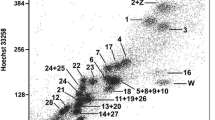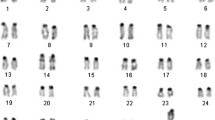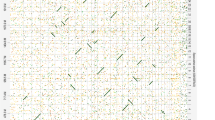Abstract
By comparing high-coverage and high-quality whole genome sequence assemblies it is now possible to reconstruct putative ancestral progenitor karyotypes, here called protokaryotypes. For this study we used the recently described electronic chromosome painting technique (E-painting) to reconstruct the karyotype of the 85 million-year-old (MYA) ferungulate ancestor. This model is primarily based on dog (Canis familiaris) and cattle (Bos taurus) genome data and is highly consistent with comparative gene mapping and chromosome painting data. The protokaryotype bears 23 autosomal chromosome pairs and the sex chromosomes and preserves most of the chromosomal associations described previously for the boreo-eutherian protokaryotype. The model indicates that five interchromosomal rearrangements occurred during the transition from the boreo-eutherian to the ferungulate ancestor. From there on 66 further interchromosomal rearrangements took place in the lineage leading to cattle and 61 further interchromosomal rearrangements in the lineage to dog.
Similar content being viewed by others
References
Bailey JA, Gu Z, Clark RA et al. (2002) Recent segmental duplications in the human genome. Science 297: 1003–1007.
Bourque G, Pevzner PA, Tesler G (2004) Reconstructing the genomic architecture of ancestral mammals: lessons from human, mouse, and rat genomes. Genome Res 14: 507–516.
Bourque G, Zdobnov EM, Bork P, Pevzner PA, Tesler G (2005) Comparative architectures of mammalian and chicken genomes reveal highly variable rates of genomic rearrangements across different lineages. Genome Res 15: 98–110.
Chowdhary BP, Raudsepp T, Froenicke L, Scherthan H (1998) Emerging patterns of comparative genome organization in some mammalian species as revealed by Zoo-FISH. Genome Res 8: 577–589.
Dutrillaux B (1979) Chromosomal evolution in primates: tentative phylogeny from Microcebus murinus (Prosimian) to man. Hum Genet 48: 251–314.
Froenicke L (2005) Origins of primate chromosomes – as delineated by Zoo-FISH and alignments of human and mouse draft genome sequences. Cytogenet Genome Res 108: 122–138.
Froenicke L, Müller-Navia J, Romanakis K, Scherthan H (1997) Chromosomal homeologies between human, harbor seal (Phoca vitulina) and the putative ancestral carnivore karyotype revealed by Zoo-FISH. Chromosoma 106: 108–113.
Froenicke L, Wienberg J, Stone G, Adams L, Stanyon R (2003) Towards the delineation of the ancestral eutherian genome organization: comparative genome maps of human and the African elephant (Loxodonta Africana) generated by chromosome painting. Proc R Soc Lond B Biol Sci 270: 1331–1340.
Froenicke L, Caldés MG, Graphodatsky A et al. (2006) Are molecular cytogenetics and bioinformatics suggesting diverging models of ancestral genomes? Genome Res 16: 306–310.
Jauch A, Wienberg J, Stanyon R et al. (1992) Reconstruction of genomic rearrangements in great apes and gibbons by chromosome painting. Proc Natl Acad Sci USA 89: 8611–8615.
Kohn M, Hoegel J, Vogel W et al. (2006) Reconstruction of a 450-My-old ancestral vertebrate protokaryotype. Trends Genet 22: 203–210.
Liu GE, Matukumalli LK, Sonstegard TS, Shade LL, Van Tassell CP (2006) Genomic divergences among cattle, dog and human estimated from large-scale alignments of genomic sequences. BMC Genomics 7: 140.
Ma J, Zhang L, Suh BB et al. (2006) Reconstructing contiguous regions of an ancestral genome. Genome Res 16: 1557–1565.
Murphy WJ, Stanyon R, O’Brien SJ (2001) Evolution of mammalian genome organization inferred from comparative gene mapping. Genome Biol 2: Reviews 0005.
Murphy WJ, Froenicke L, O’Brien SJ, Stanyon R (2003) The origin of human chromosome 1 and its homologs in placental mammals. Genome Res 13: 1880–1888.
Murphy WJ, Pevzner PA, O’Brien J (2004) Mammalian phylogenomics comes of age. Trends Genet 20: 631–639.
Murphy WJ, Larkin DM, Everts-van der Wind A et al. (2005) Dynamics of mammalian chromosome evolution inferred from multispecies comparative maps. Science 309: 613–618.
Nash WG, O’Brien SJ (1982) Conserved regions of homologous G-banded chromosomes between orders in mammalian evolution: carnivores and primates. Proc Natl Acad Sci USA 79: 6631–6635.
Ohno S (1967) Sex Chromosomes and Sex Linked Genes. Heidelberg: Springer.
Pevzner P, Tesler G (2003) Genome rearrangements in mammalian evolution: lessons from human and mouse genomes. Genome Res 13: 37–45.
Rettenberger G, Klett C, Zechner U et al. (1995) ZOO-FISH analysis: cat and human karyotypes closely resemble the putative ancestral mammalian karyotype. Chromosome Res 3: 479–486.
Richard F, Lombard M, Dutrillaux B (2003a) Reconstruction of the ancestral karyotype of eutherian mammals. Chromosome Res 11: 605–618.
Richard F, Messaoudi C, Bonnet-Garnier A, Lombard M, Dutrillaux B (2003b) Highly conserved chromosomes in an Asian squirrel (Menetes berdmorei, Rodentia: Sciuridae) as demonstrated by ZOO-FISH with human probes. Chromosome Res 11: 597–603.
Stanyon R, Stone G, Garcia M, Froenicke L (2003) Reciprocal chromosome painting shows that squirrels, unlike murid rodents, have a highly conserved genome organization. Genomics 82: 245–249.
Szamalek JM, Goidts V, Cooper DN, Hameister H, Kehrer-Sawatzki H (2006) Characterization of the human lineage-specific pericentric inversion that distinguishes human chromosome 1 from the homologous chromosomes of the great apes. Hum Genet 120: 126–138.
Wienberg J (2004) The evolution of eutherian chromosomes. Curr Opin Genet Dev 14: 657–666.
Yang F, Alkalaeva EZ, Perelman PL et al. (2003) Reciprocal chromosome painting among human aardvark, and elephant (superorder Afrotheria) reveals the likely eutherian ancestral karyotype. Proc Natl Acad Sci USA 100: 1062–1066.
Yunis JJ, Prakash O (1982) The origin of man: a chromosomal pictorial legacy. Science 215: 1525–1530.
Author information
Authors and Affiliations
Corresponding author
Electronic Supplementary Material
Below is the link to the electronic supplementary material.
Table 1
Supplementary Table 1 (DOC 44 544 kb).
Rights and permissions
About this article
Cite this article
Kemkemer, C., Kohn, M., Kehrer-Sawatzki, H. et al. Reconstruction of the ancestral ferungulate karyotype by electronic chromosome painting (E-painting). Chromosome Res 14, 899–907 (2006). https://doi.org/10.1007/s10577-006-1097-7
Received:
Revised:
Accepted:
Published:
Issue Date:
DOI: https://doi.org/10.1007/s10577-006-1097-7




